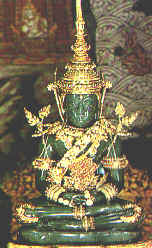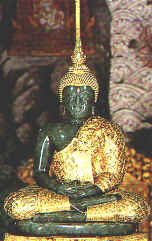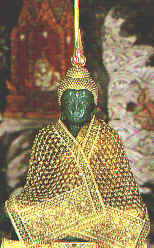|
|
North of Royal Residence of Maha Monthian, from which there is connecting gate , lies the ground of Chapel Royal of Buddha. It consists of all the architecture features of monastery without however residential quarter, for monks do not live here. Assembly Hall, or Ubosoth, serves as the monarch's private chapel.
Hence the partition on either side of the main alter intended as retiring room, which is never to be found anywhere else but the only other chapel royal, that of King of Thornburi, which serves now as Assembly Hall of the monastery of Arun, within the former grounds of the palace of that King.
"Emerald Buddha", is carved from a block of jade. It is an object of national veneration and crowds come in to pay respect to the memory of Buddha and His Teachings, on certain days of the weeks, when it is open to the public. Emerald Buddha sits high up on gold alter, designed to represent the traditional aerial chariot, attributed to Hindu gods on the murals of this country.
The effigy was first discovered in Chiang Rai in 1464, brought down to Lampang, where it remained till King Tilok of Lannathai brought it to Chiang Mai, his capital, where it was fitly enshrined.
Later on, there occurred vacancy in Lannathai line of succession and King Chaichetta of Luang Prabang, whose mother was Chiang Mai Princess, was invited to fill it. He however returned to his native land in Luamg Prabang, after comparatively short rule here, taking the palladium with him back to his capital. Then King Chiachetta moved his capital to newly built town of "Viang Chan ", taking Emerald Buddha again with him.
It remained there for long time, till King of Thornburi sent punitive expedition under Chao Phraya Chakri to Viang Chan, which brought back with it the famous effigy, of which King of Thornburi was very proud.
When King Rama I built the city of Bangkok with Chapel Royal and Grand Palace, Emerald Buddha was installed with pomp and ceremony in the Chapel.
In front of the high alter, Rama III set up two newly cast standing images of Lord, in dedication to his predecessors on the throne, which were named "Phra Phuttha Yod Fa Chula Lok" and "Phra Phutta Loetla Sulalai".
At that time, it was deemed impolite to refer to elders by their personal names. Rama I was usually spoken of as Initial Reign, Rama II as "Middle Reign" and Rama III, Present Reign. Obviously such nomenclature could not last and by Royal Decree , founder of the dynasty, was to be referred to as His Majesty of the image of Phra Phutttha Yod Fa Chula Lok and hisSuccessor as His Majesty of the image of Phra Phuttha Loetla Sulalai.
Rama VI decreed the expediency of referring to his predecessors simply as Rama, with due ordinal numbers, because all of his predecessors bore the name Rama among other names in full official Style and Title. There is another effigy, Samphutthapanni Buddha images, held in high veneration and placed in front of the high altar. The image was cast by King Mingkut, Rama IV, when he was monk.
Murals within this building are:
1- Above the window frames, traditional life-story of Buddha commencing with Southwest corner, in the right hand of high altar, where is depicted his birth, childhood, youth and renunciation in search of Truth; on East wall, fronting high altar, temptation and enlightenment, the figure underneath Buddha's seat being that of Mother Earth; continuing thence along North wall, the mission and death with its immediate consequence till we reach Northwest corner of the wall. At the back is painted the middle-aged conception of the universe.
2- Between windows are depicted some of the so-called birth-stories.
3- Behind the window pabel are murals illustrating Proverb rhymes.
4- Some of the panels of the doors contain exquisite inlaid work in mother-of-pearl. They all depict episodes from Ramakien (Thai version of Ramayana).

Summer

Rainy Season

Winter
|
|



